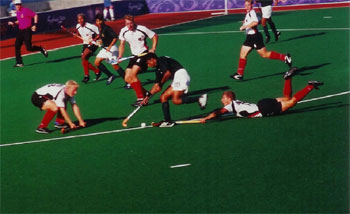Flat Footed
Indoor-Style Tackle

For more coaching information, visit www.coachshiv.com
| January | February | March |
|
April | May | June |
|  |
|||||
| July | August | September | October | November | December | |
![]()
INTRODUCTION
The aim of Tackling is to to regain the possession of the ball from the opponent, in a dynamically changing game situation. Some concepts we need to bear in mind when understanding tackling are:
| Timing |
Timing is key to Tackling - Knowing when to tackle is probably more important than knowing how to tackle.
| Position-specific Tackling |
The tackling styles of a deep defender, a midfielder and a forward are quite different. If we understand this difference, tackling becomes much more effective.
| Variations of a Tackling Style |
Different teams and nations may use their own variations of the same Tackling style. For instance, what Indians may call a Poke Tackle would be called a Jab Tackle by the Australians, and each uses its own variation of this tackle.
TYPES OF TACKLES
There are various types of tackles used in modern hockey:
In this article, we will just focus on the Indoor-style Tackle, and discuss its advantages, disadvantages, game situations where to use it, and when not to use it.
WHAT IS INDOOR-STYLE TACKLING?
This is a style of tackle where a player, usually a defender, tackles the opponent player who has the ball, by going down on his/her heels almost to the point of sitting, laying the stick flat on the ground, and aiming to physically block the opponent's progress with the ball.
See the two photographs below for examples of indoor-style tackling - the Malaysian player bending low with stick flat on the ground (Photograph 1, extreme right), and the German player bending low with stick flat on the ground (Photograph 2, extreme left).
Indoor-style tackling was introduced to the world of hockey in the mid-1970s by the Germans. This style evolved from the indoor hockey played during the winter season in Germany. Though this style is primarily used by Germany, Netherlands and other Europeans teams, this style has become more prevalent in other continental teams also.
In my opinion, most hockey players employ indoor-style tackling more than necessary, at the cost of the traditional styles of tackling (which, by the way, are still very much in vogue in football and basketball).
| Photo 1: 2000 Sydney Olympics, Spain vs. Malaysia |
 |
| Photo 2: 2000 Sydney Olympics, Pakistan vs. Germany |
 |
ADVANTAGES OF INDOOR-STYLE TACKLING
Indoor-style tackling, when done at the right time, can be highly effective in a restricted space where the opponent who has the ball does not have many options. This style of tackling is also effective against forwards who dribble with their heads down.
Confined spaces where an indoor-style tackle can be used are:
DISADVANTAGES OF INDOOR-STYLE TACKLING
The player employing the indoor-style tackle is flat-footed and on his heels, bent low and almost sitting down. The disadvantage of such a stance is that the defending player becomes static and frozen in the given game situation, making it difficult to recover quickly.
Also, the defending player has clearly shown the space which can be covered, and what cannot be covered. An intelligent opponent will exploit this advantage and leave the defender vulnerable.
Therefore, one should not use indoor-style tackling in an open space, where the defender has no cover, which will give an opportunity to the opponent to easily pass by the defender. Photograph 1 above is an example of a game situation where an indoor-style tackle should not be employed.
CONCLUSION
When coaching youngsters, we must teach all the types of tackles, and not focus on only the indoor-style tackle. It is important that we educate players on when, how, where and WHY we use a style of tackle for a given game situation.
I would like to conclude this article by mentioning the Pareto Principle, also known as the 80-20 rule. The number of Indoor tackles should be around 20% of the total tackles done by a team in a game. Unfortunately, it is usually the other way around, with players resorting to indoor-style tackles 80% of the time.
Based on the advantages and disadvantages of the indoor-style tackle as described in this article, you be the judge and employ the right tackle, at the right time, for the right game situation!
![]()